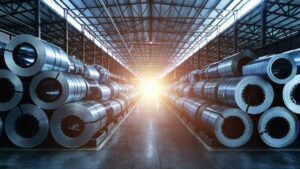China’s steel collapse is ‘unprecedented’ but will it be temporary or a long-term shift?

Pic: Bloomberg Creative / Bloomberg Creative Photos via Getty Images
The collapse in steel production in China over the past four months has been described as “unprecedented”.
It comes after the country’s steel industry produced just 71.58Mt in October, 23.3% less than the same period in 2020 and off the back of a 21%YoY fall in September.
The cuts have been made on supposedly environmental grounds, with big-emitting China pledging not to beat its 2020 steel production record of 1.065Bt having produced almost 600Mt over the first half of the year.
While the prospect of meeting that target seemed outlandish at the time, it now looks as though China could overshoot.
Iron ore market expert Mark Eames told Stockhead the collapse in crude steel output in the world’s biggest market was of an order of magnitude normally seen in major economic crises.
“The question obviously that everyone will ask is, is this a temporary cutback, or is it a structural cutback?” he said.
“If it’s a temporary cutback related to an attempt to slow down or take heat out of the steel market, or alternatively, to improve the level of air pollution, for example, then you could see things potentially coming back into balance by the end of the year.”
“So that’s one scenario. The other scenario is that if it is a production fall of this magnitude, which is the order of a quarter, then that’s suggesting there’s something much more deep-seated happening around the Chinese industrial economy.
“Steel production (cuts) of that magnitude, were they to continue, would be almost unprecedented outside of a major economic crisis or geopolitical issue.
“So that’s probably the comment I’d make is that we are seeing some big moves in Chinese steel production. And it is going to take a little bit of time to see exactly what this means for long term steel demand.”
Iron ore prices have receded along with China’s steel production cuts, with benchmark 62% fines prices falling from highs of US$237/t in May, when China produced a record 99.5Mt of crude steel, to around US$90/t yesterday and with plenty of volatility in between.
Steel complex still strong globally
One bearish factor that has been pointed out by analysts is that steel prices and profitability in China has been falling.
Reinforced bar is trading around eight-month lows at US$732.70/t yesterday with ultra high coking coal prices also eating into mill profits.
But Eames notes that steel prices are not all that low in historical terms, and prices for steel elsewhere around the world remain extremely high.
“What is worth noting is that the steel complex around the world is particularly strong,” he said.
“Steel prices are remaining relatively high, steel demand in other parts of the world is remaining high.
“And so this is an unusual thing. It was not something associated with the last times we’ve seen these sort of moves in events like the Global Financial Crisis or the fall of communism in Eastern Europe or those kinds of events.
“So we’re seeing something potentially quite unusual, I think, to see steel production fall in one country, when steel prices and demand look relatively healthy.”
One factor that has weighed on iron ore sentiment, particularly in recent weeks, has been the slowdown in the property sector, highlighted by the near default of heavily indebted property developer Evergrande and a 0.25% contraction in home price growth in October, the steepest since February 2015.
While rebar is sold into this sector, Eames said it is not a determinant of demand on its own.
“There’s no question that there is steel used in construction, so obviously it’s a big source of demand for reinforcing bar. But that reinforcing bar is also used in lots of other applications, such as infrastructure, roads, bridges, etc,” Eames said.
“A lot of public sector works are still going to rely on steel demand. So housing is a significant demand sector in China, but it’s not overwhelming.”
The nature of steel cuts could determine prices
Some small scale, higher cost producers in Australia have exited the market in response to the slide in iron ore prices.
Vale has also made moves to reduce its low margin supply, but big iron ore producers and those with attractive grade premiums are still making good money right now.
Eames said prices would need to fall further from current levels to cause a major supply response from significant players like BHP (ASX:BHP), FMG (ASX:FMG) and Rio Tinto (ASX:RIO).
“If you look at (current prices) historically, that’s a little bit below the 10-year average but it’s actually a pretty good price for iron ore,” Eames said.
“The iron ore producers would be doing quite well with that and the high grade iron ore producers will be doing quite well indeed, because the premiums are quite good.
“The other thing to comment about is that, from a supplier perspective, one of the big things is that freight rates have dramatically fallen as well.
“So particularly for more distant producers in places like Brazil, their trading conditions have improved a lot, because their net back is not so bad.
“I don’t think for any of the established players, a price of $90-95 is a catastrophe.”
Some established companies would have trading issues at around US$60/t, Eames said, but he believes if the steel production cuts are only temporary prices could bounce back with demand.
“If it turns out, I think, that the steel production slowdown in China is temporary, then I think you’ll see the sea prices rapidly respond,” he said.
Rinehart deal signals shift to higher grades
Another feature of the shift in the iron ore market in recent months has been the flight to quality, with miners looking to boost their grade profiles.
This is being driven by commercial imperatives on one side; lower grade ores like those produced by Fortescue (ASX:FMG) and Mineral Resources (ASX:MIN) are copping hefty discounts to benchmark prices.
But it is also coming from the same universe of logic as China’s production cuts themselves. Producing steel from iron ore in a blast furnace currently produces more CO2 than it does steel.
Higher grade ores are cleaner and more efficient, and can be used in future-facing steel mill processes that produce fewer greenhouse gases such as direct reduced iron.
Australia’s richest woman Gina Rinehart dipped her toes into the field this week, with her company Hancock Prospecting announcing it would make a $9 million investment to take a 30% stake in the Mt Bevan magnetite project near Kalgoorlie currently owned 60-40 by Indian-backed Legacy Iron Ore (ASX:LCY) and Hawthorn Resources (ASX:HAW).
While grade premiums have been a long term feature of the iron ore marker, Eames, a former Glencore, BHP, Rio Tinto and X-Strata executive who is the technical director for junior iron ore developer Magnetite Mines (ASX:MGT), said a shift in thinking had gathered pace over the past six months.
“I think the need for higher grade ore products has gone from being a theory to an accepted reality,” he said.
“So I think most participants in the market in the last six months have changed very rapidly to recognise that we need to move to a world with lower emissions.”
There are only a handful of places around the world that are naturally endowed with high grade direct shipping ore (for instance, Brazil’s Carajas region and the Simandou ore body in Guinea).
Because of that, demand for processed concentrates is likely to grow.
“I would comment that BHP and Vale have a large investment in processed ore already in the Samarco project in Brazil, that unfortunately had a dam collapse a number of years ago, but that’s a very high grade, processed iron ore producer,” Eames said.
“And Rio of course owns the Iron Ore Company of Canada, which also is a high grade iron ore producer there. So the majors already have some experience of processed ores.
“So it wouldn’t in my view be a big step for them to start to reengage around getting involved in some of these sort of potentially high grade deposits around the world.
“I think it’s early days in that whole, if you like, something of a paradigm shift in the industry in terms of the way higher grade ore products made from magnetite and similar ore bodies are being perceived.”
Is China in slowdown mode?
Many economic indicators, particularly in the property market, would suggest China is entering a slowdown of sorts.
That said, China is yet to announce a policy for steel production beyond 2021, and the end of the Winter Olympics in Beijing in February could bring a cooling of policies designed to limit pollution.
Eames says it is too early to tell how the situation will unfold.
“It’s really an unprecedented time in the last 20-odd years in that China’s really been an engine of growth for the world in general and steel in particular, especially iron ore of course,” he said.
“I think everybody, including us in Australia, are having to interpret the narrative.
“We’re getting very mixed signals out of China on a whole range of areas. And I think this is one more, it is as Winston Churchill said about Russia, ‘an enigma wrapped up in a conundrum’.
“If there’s a shift in the Chinese industrial economy, then I think that’s going to have huge implications.
“My view is I think it’s unlikely – I don’t think China’s suddenly shifted gear from being a major growing economy into slowdown mode. I think that sounds a bit extreme to me, but again, time will tell.”
At Stockhead, we tell it like it is. While Magnetite Mines is a Stockhead advertiser, it did not sponsor this article.
Related Topics
UNLOCK INSIGHTS
Discover the untold stories of emerging ASX stocks.
Daily news and expert analysis, it's free to subscribe.
By proceeding, you confirm you understand that we handle personal information in accordance with our Privacy Policy.








